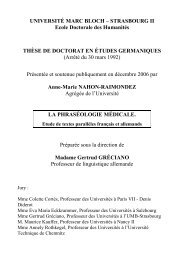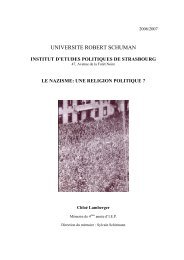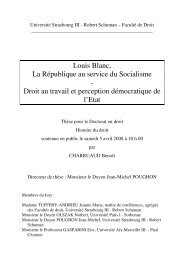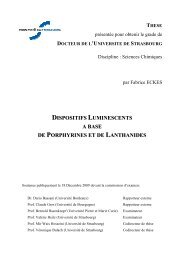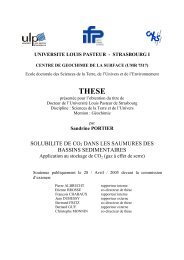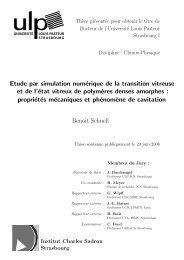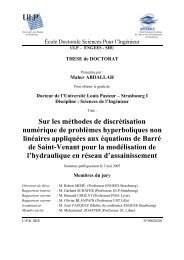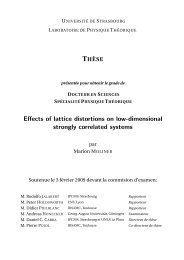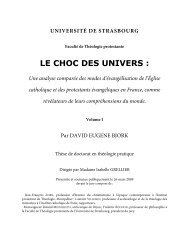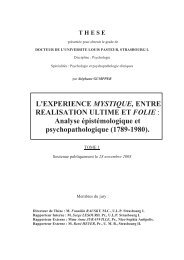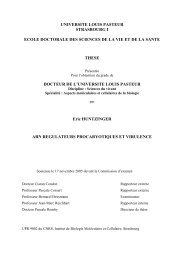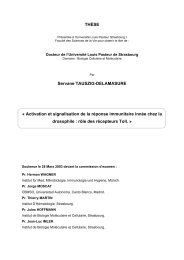Anthony KERMAGORET - THESES ET MEMOIRES DE L'UDS
Anthony KERMAGORET - THESES ET MEMOIRES DE L'UDS
Anthony KERMAGORET - THESES ET MEMOIRES DE L'UDS
You also want an ePaper? Increase the reach of your titles
YUMPU automatically turns print PDFs into web optimized ePapers that Google loves.
N2-Ni1-Cl1 169.45(12) 89.35(15)<br />
N2-Ni1-Cl1′ 90.48(12) 169.36(13)<br />
O3-Ni1-Cl1 92.57(12) 93.41(13)<br />
O3-Ni1-Cl1′ 93.51(12) 95.95(15)<br />
Cl1-Ni1-Cl1′ 86.84(8) 85.48(5)<br />
Ni1-Cl1-Ni1 93.16(8) 93.90(5)<br />
N2-Ni1-O3 77.40(18) 77.87(19)<br />
O1-C1-C2 106.3(4) 109.1(6)<br />
C1-C2-N1 123.1(5) 116.8(6)<br />
C2-N1-Ni1 114.0(4) 115.8(4)<br />
Ni1-O3-C7 113.8(4) 113.7(4)<br />
O3-C7-C8 106.4(5) 109.6(7)<br />
C7-C8-N2 123.3(5) 115.9(6)<br />
C8-N2-Ni1 113.6(4) 116.1(4)<br />
Chapitre II<br />
The dications in 14·C6H12 and in 15·3CH2Cl2 form centrosymmetric dimers and their Ni(II)<br />
centres adopt a distorted octahedral coordination geometry, very similar to those of 11 and 12<br />
which contain gem-dimethyl substituents in α-position to the OH donor. 54 Each Ni(II) is<br />
surrounded by two N,O chelates, whose N and OH donor groups are cis and trans to each<br />
other, respectively, and by two bridging chlorides which are trans to the nitrogen atoms. The<br />
crystal structure of 15·3CH2Cl2 revealed two independent but almost identical molecules in<br />
the unit cell. In both 14 and 15, the two chloride counter anions do not interact with the metal<br />
centres and are at 4.702(3) and 4.713(3) Å for 14 and 4.535(2) and 4.552(2) Å for 15 from a<br />
Ni(II) centre. However, interactions between the chloride counter anions and the hydrogen<br />
atoms of the OH functions are observed, with O1-H1···Cl2 and O3’-H3’···Cl2 distances of<br />
2.984(4) and 2.994(4) Å (Table S1†), for 14 and 2.993(4) and 2.972(5) Å (Table S2†), for 15,<br />
respectively (calculated O1-H1···Cl2 and O3’-H3’···Cl2 angles of 158 and 158 ° for 14 (Table<br />
S1†) and 157 and 162 °, for 15, respectively (Table S2†). As shown by the O1-Ni-O2 angle<br />
of 171.7(2)° for 14·C6H12 against 168.2(2)° for 11, the metal centre in 14·C6H12 has a<br />
coordination geometry less distorted than in 11. Compared to 11, 14·C6H12 presents slightly<br />
shorter Ni-N and Ni-Cl distances.<br />
Complex 15 has similar structural characteristics to 12 and these will therefore not be<br />
discussed in detail. The structure of a nickel complex coordinated by two (pyridin-2-<br />
yl)methanol ligands has been described recently but the coordination of two water molecules<br />
led instead to a mononuclear structure with an octahedral nickel centre. 56<br />
Complex 15 has been obtained recently in a less convenient way by reaction of the<br />
phosphinitopyridine ligand 16 with NiCl2 in MeOH. This reaction led to the cleavage of the<br />
P-O bond and formation of 15 and [NiCl2(PPh2OMe)2] [eqn (4)]. 57<br />
8



